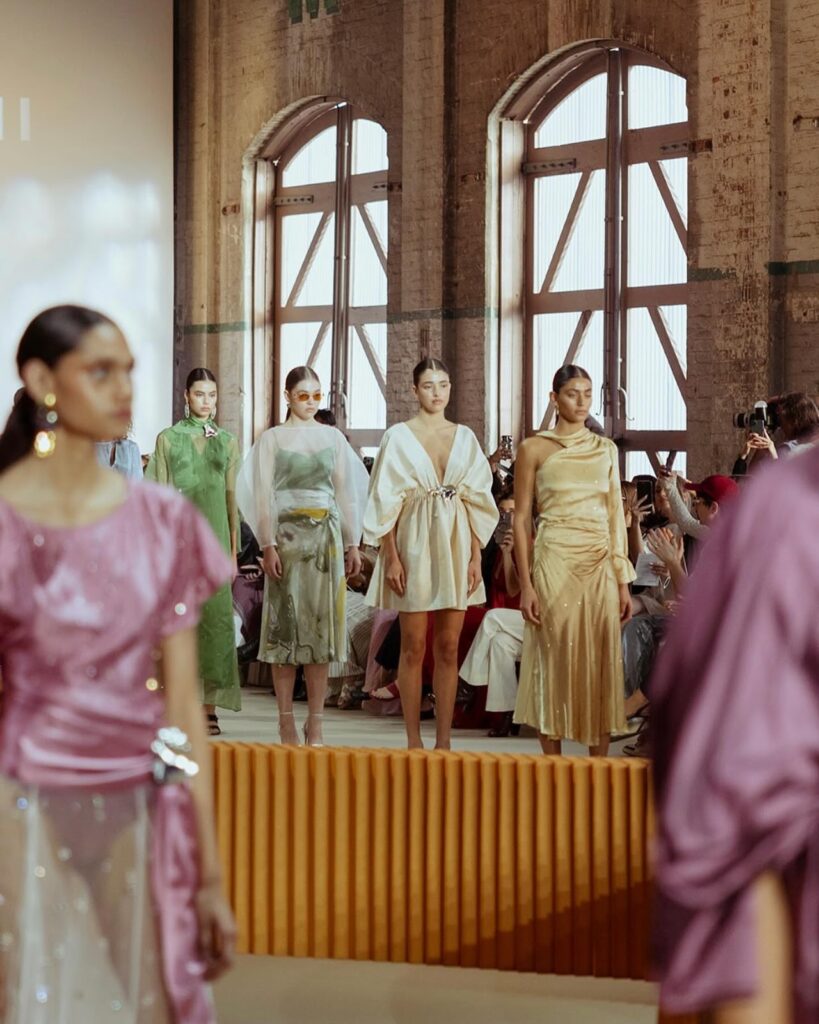The future of fashion is more exciting than ever, with digital advancements pushing the boundaries of design, creativity, and commerce. The rise of the metaverse is revolutionising how fashion is conceptualised, created, and consumed. This blog explores the intersection of fashion and technology, focusing on virtual runways, augmented reality (AR), and 3D fashion technology.
.jpeg)
- Introduction
- Overview of Fashion in the Metaverse
- The Role of Technology in Shaping the Future of Fashion
- The Evolution of Fashion in the Digital Age
- How Fashion is Adapting to the Metaverse
- Key Innovations Driving Virtual Fashion
- Virtual Fashion Shows and Digital Runways
- The Rise of Virtual Fashion Shows
- Major Brands Embracing Digital Fashion Events
- Virtual Fashion Shows vs. Traditional Runways
- 3D Fashion Technology and Its Impact on Design
- What is 3D Fashion Technology?
- Benefits of 3D Fashion for Designers and Consumers
- Case Studies: Leading Brands Using 3D Fashion Technology
- Augmented Reality Fashion and Virtual Try-Ons
- Augmented Reality (AR) in Fashion: What to Expect
- Virtual Try-On Tools Revolutionizing Shopping Experiences
- AR Fashion in Retail: Case Studies and Future Projections
- Digital Fashion Trends: What's Next?
- Top Digital Fashion Trends to Watch in 2024
- The Role of Digital Avatars in Personal Style
- How the Fashion Industry is Capitalizing on Digital-Only Collections
- Monetizing Fashion in the Metaverse
- Digital Wardrobes and NFT Fashion
- Revenue Projections for Virtual Fashion Marketplaces
- The Future of Digital Ownership in Fashion
- Fashion and Sustainability in the Virtual World
- Can Digital Fashion Reduce Waste?
- The Environmental Impact of Virtual Fashion Shows and Metaverse Fashion
- The Role of the Metaverse in Global Fashion Trends
- How the Metaverse is Shaping International Fashion Trends
- Cultural Influence and Fashion Innovation in the Virtual World
- Amor Design Institute: Preparing Designers for the Metaverse
- How Amor Design Institute Integrates Digital Fashion in its Curriculum
- Challenges and Opportunities in Digital Fashion
- Key Challenges Facing Designers in the Metaverse
- Opportunities for Innovation in Virtual Fashion and Design
- Conclusion
- The Future of Fashion and the Metaverse
- Why Fashion Designers Should Embrace Digital Fashion Trends
- FAQs
- What is the metaverse in fashion?
- What is virtual fashion?
- How does VR affect the fashion industry?
- What is the metaverse trend?
- How Does the Metaverse Impact Fashion Trends?
1. Introduction
Overview of Fashion in the Metaverse
- The metaverse is a digital universe where users can interact, shop, and socialize using avatars in a virtual world.
- Fashion has quickly adapted to this new reality, with designers and brands experimenting with virtual runways, digital fashion collections, and even AR-based shopping experiences.
The Role of Technology in Shaping the Future of Fashion
- Technologies like AR, VR (virtual reality), and 3D design tools reshape how fashion is produced and consumed.
- As fashion moves into the digital age, consumers are experiencing fashion in entirely new ways, through virtual try-ons, NFTs, and immersive fashion shows.
Explore more here about the role of technology in modern fashion design.
2. The Evolution of Fashion in the Digital Age

How Fashion is Adapting to the Metaverse
- Fashion expands beyond the physical realm, with digital garments becoming mainstream through virtual fashion shows and digital clothing collections.
- Designers now cater to digital avatars, creating fashion for the metaverse’s immersive world.
Key Innovations Driving Virtual Fashion
- 3D fashion technology enables designers to create virtual garments that avatars can wear in video games or social VR spaces.
- AR fashion lets consumers visualize how clothing looks on them before buying, reducing the need for physical fitting rooms.
Know more about The Evolution of Fashion Design Education
3. Virtual Fashion Shows and Digital Runways

The Rise of Virtual Fashion Shows
- Virtual fashion shows allow brands to showcase their latest collections to a global audience without geographic limitations.
- Events like Paris Fashion Week and Milan Fashion Week have adopted virtual platforms to reach consumers worldwide.
Major Brands Embracing Digital Fashion Events
- Leading brands like Balenciaga and Gucci have hosted virtual runways, providing an immersive experience for their audiences.
Virtual Fashion Shows vs. Traditional Runways
- Traditional fashion shows are limited by venue size and audience reach, while virtual fashion shows allow unlimited attendance and interactivity.
- Virtual runways are more sustainable, reducing travel and physical production waste.
4. 3D Fashion Technology and Its Impact on Design

What is 3D Fashion Technology?
- 3D fashion technology uses digital tools to design, prototype, and even sell virtual clothing.
- Designers use software like CLO 3D and Marvelous Designer to create detailed 3D garments.
Benefits of 3D Fashion for Designers and Consumers
- For designers: Streamlined workflow, quicker iterations, and reduced waste.
- For consumers: Ability to virtually try on clothes and access unique digital-only fashion items.
Case Studies: Leading Brands Using 3D Fashion Technology
- Tommy Hilfiger and The Fabricant lead in integrating 3D fashion technology into their design processes.
5. Augmented Reality Fashion and Virtual Try-Ons

Augmented Reality (AR) in Fashion: What to Expect
- AR is rapidly changing the way people shop for clothes. It allows them to see how an outfit will look without physically trying it on.
Virtual Try-On Tools Revolutionizing Shopping Experiences
- AR apps from brands like Zara and ASOS allow consumers to "try on" garments using their smartphones.
AR Fashion in Retail: Case Studies and Future Projections
- IKEA’s AR app allows users to visualise furniture in their homes, and fashion brands are adopting similar strategies for clothing.
6. Digital Fashion Trends: What's Next?
Top Digital Fashion Trends to Watch in 2024
- NFT fashion: Digital-only clothing consumers can "own" in the metaverse.
- Sustainability: Digital fashion reduces the need for physical production, promoting eco-friendly practices.
The Role of Digital Avatars in Personal Style
- Users can customise their avatars with digital fashion pieces, reflecting their style in virtual environments.
How the Fashion Industry is Capitalizing on Digital-Only Collections
- Digital fashion brands like DressX create collections solely in the digital world, available by avatars.
Check Fashion Trends for the Next Decade here.
7. Monetizing Fashion in the Metaverse
Digital Wardrobes and NFT Fashion
- NFTs (non-fungible tokens) allow users to buy, sell, and trade digital fashion pieces, creating new opportunities for brands and designers.
Revenue Projections for Virtual Fashion Marketplaces
- The virtual fashion market is expected to exceed billions in revenue by 2030, driven by virtual runways and digital clothing sales.
The Future of Digital Ownership in Fashion
- As virtual wardrobes become more common, owning digital fashion will be as valuable as physical clothing.
8. Fashion and Sustainability in the Virtual World
Can Digital Fashion Reduce Waste?
- Since digital fashion doesn't require physical production, it offers a more sustainable alternative to traditional fashion.
The Environmental Impact of Virtual Fashion Shows and Metaverse Fashion
- By hosting events in the metaverse, brands reduce their carbon footprint, eliminating the need for travel and physical production.
9. The Role of the Metaverse in Global Fashion Trends
How the Metaverse is Shaping International Fashion Trends
- The metaverse transforms fashion trends by enabling global participation, making fashion more inclusive.
Cultural Influence and Fashion Innovation in the Virtual World
- Fashion in the metaverse allows designers to blend cultural influences worldwide, fostering innovation and creativity.
10. Amor Design Institute: Preparing Designers for the Metaverse
How Amor Design Institute Integrates Digital Fashion in its Curriculum
- Amor Design Institute offers cutting-edge courses in Fashion Design, preparing the next generation of designers for the digital world.
11. Challenges and Opportunities in Digital Fashion
Key Challenges Facing Designers in the Metaverse
- Navigating the new digital landscape and finding ways to monetize virtual collections can be challenging for designers.
Opportunities for Innovation in Virtual Fashion and Design
- There are endless opportunities for innovation, including creating interactive digital garments and leveraging NFT technology for fashion collections.
12. Conclusion
The Future of Fashion and the Metaverse
- The metaverse is set to revolutionize the fashion industry, offering new opportunities for designers and consumers.
Why Fashion Designers Should Embrace Digital Fashion Trends
- Embracing digital fashion allows designers to expand their reach, reduce waste, and tap into the future of fashion.
13. FAQs
- What is the metaverse in fashion?
- The metaverse refers to a virtual world where fashion brands can host digital events and sell virtual clothing for avatars.
- What is virtual fashion?
- Virtual fashion refers to clothing designed for digital environments, often worn by avatars or used in virtual fashion shows.
- How does VR affect the fashion industry?
- VR allows for immersive fashion experiences, from virtual try-ons to fully virtual fashion shows.
- What is the metaverse trend?
- The metaverse trend involves fashion brands moving into the digital space, creating virtual runways, NFTs, and digital fashion collections.
- How Does the Metaverse Impact Fashion Trends?
- The metaverse allows global audiences to engage with fashion, making trends more accessible and inclusive.













